
Tillage systems have been evaluated for reduced costs, more surface residue, less soil compaction, more uniformity, finer seedbeds, and improved drainage. Cool wet springs have us asking for one more thing - more planting days.
The 2003 and 2004 planting seasons left many growers scrambling to get corn planted on time. In some cases, rains came hard and heavy and chased producers from the field for a week but, in other cases, fields went through several cycles of being "just about ready" when a shower would stop field work for the next day. Growers face several alternatives to improve planting timeliness; install more tile drainage, get bigger equipment, or modify tillage systems to increase the number of planting days. Indeed, one of the drawbacks to no-till systems is the delay experienced in the soil drying to a point were you can plant. Proponents of no-till systems argue that by the time their neighbour gets his chisel plowed field cultivated three times, both are ready to plant at the same time. Over the past ten years strip tillage and stale seed bed systems have been examined from the perspectives of reducing costs, conserving soil and improving the timing of corn planting.
Strips Have Some Success
In our (my) dreams we saw fall strip tillage as being able to,
1) improve planting timing,
2) boost corn yields, and
3) provide a way to fall apply P and K in a band where next years corn would be planted. The reality is that strip tillage on medium textured soils has not had that great an impact on yields, and we have shown that banding P and K in the fall behind the strip-till shank is a nice way to hide the fertilizer from the corn plant! However, the advantage of having a row zone that was drier and more fit for planting, compared to the no-till ground beside it, has been quite real and measurable. Research on field sites continues to show support for the idea that a properly formed berm or strip in the fall, can significantly improve soil dry-down and hence planting timeliness.

Figure 1 outlines soil moistures taken in the pre-planting period and shows the significant gains over no-till in terms of having soil that is fit for planting. The other advantage from a planting perspective, is that the inter-rows remain undisturbed and can quite often bear wheel traffic better in the spring than tilled ground. Mark Comley cash cropper and Integrated Grain Processors Cooperative (IGPC) Director from the Ancaster area, has spent several years now trying to fine-tune corn planting within a strip tillage system. He is convinced that on his heavier soils, planting directly into fall strips
improves the odds of getting his corn planted on time. "I would far sooner be chased from the fields by rain after having planted all day on strips, than to see it rain just as we were about to get the planter into a conventionally cultivated field," exclaims Comley. Fall strip tillage, which leaves a residue-free, uniform berm that is still elevated enough in the spring to both see and be planter ready, is not as easy to do as one might expect. In wheat stubble, having the straw baled, weeds controlled and being free of red clover all improve the odds of success.
 |
Looking for a Faster Start For those growers not interested in strip tillage, adopting a tillage system that allows for more timely planting may revolve around some form of mulch tillage, which manages residue and does some soil mixing, but leaves the soil surface level enough to plant directly in the spring without any secondary tillage. Some University of Guelph work showed that a level disking of wheat stubble (straw removed) and direct planting in the spring was reasonably competitive to conventional tillage systems when it came to corn yields (see Table 1).
|
|
| Mark Comley of Ancaster, Ontario is encouraged by planting timing on fall strips. |
Looking for a Faster Start
For those growers not interested in strip tillage, adopting a tillage system that allows for more timely planting may revolve around some form of mulch tillage, which manages residue and does some soil mixing, but leaves the soil surface level enough to plant directly in the spring without any secondary tillage. Some University of Guelph work showed that a level disking of wheat stubble (straw removed) and direct planting in the spring was reasonably competitive to conventional tillage systems when it came to corn yields (see Table 1).
Cost versus Benefits
Moving to strip tillage, stale seedbed or other approaches which minimize delays in planting, will impose some challenges in terms of weed control, nitrogen application, field smoothness, etc. However, the costs associated with delayed plantings due to lower yields, late harvests and higher drying costs, may warrant a hard look at making planting timeliness your number one priority.